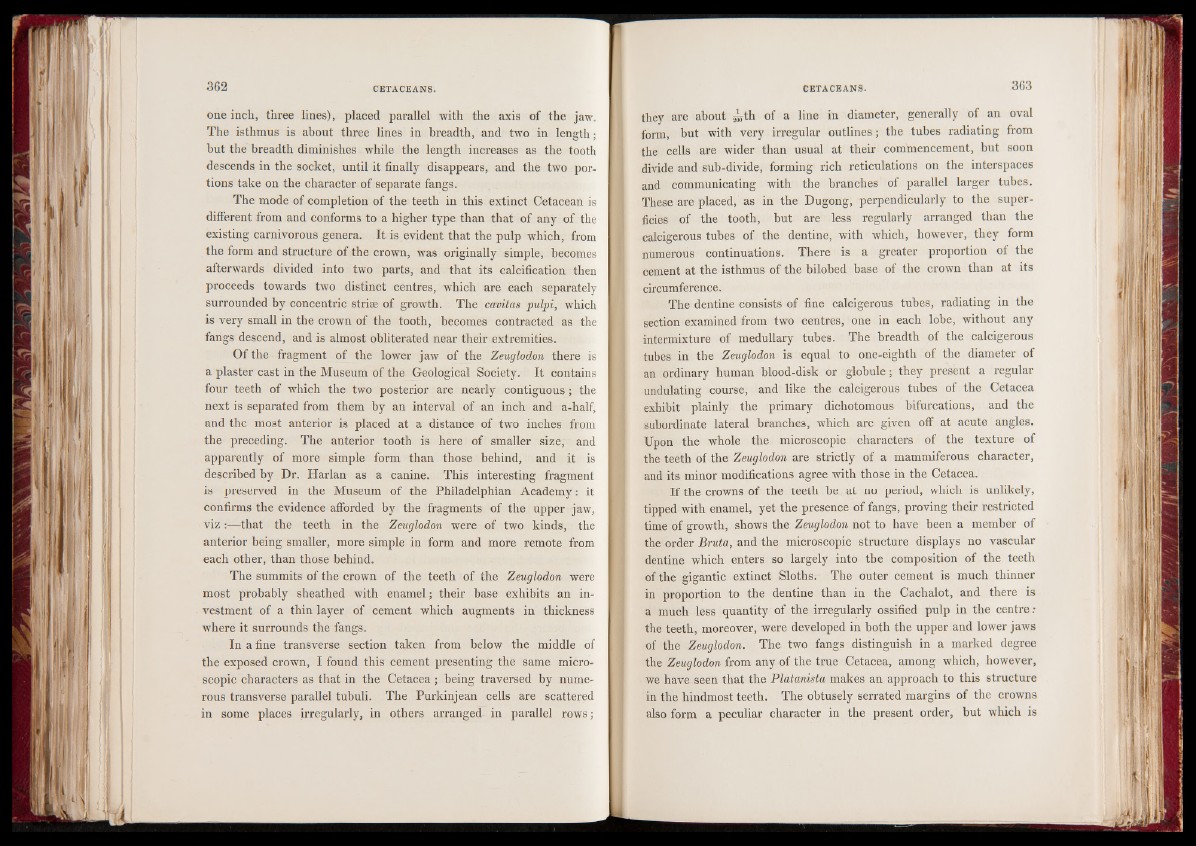
one inch, three lines), placed parallel with the axis of the jaw.
The isthmus is about three lines in breadth, and two in length;
but the breadth diminishes while the length increases as the tooth
descends in the socket, until it finally disappears, and the two portions
take on the character of separate fangs.
The mode of completion of the teeth in this extinct Cetacean is
different from and conforms to a higher type than that of any of the
existing carnivorous genera. It is evident that the pulp which, from
the form and structure of the crown, was originally simple, becomes
afterwards divided into two parts, and that its calcification then
proceeds towards two distinct centres, which are each- separately
surrounded by concentric striae of growth. The cavitas pulpi, which
is very small in the crown of the tooth, becomes contracted as the
fangs descend, and is almost obliterated near their extremities.
Of the fragment of the lower jaw of the Zeuglodon there is
a plaster cast in the Museum of the Geological Society. It contains
four teeth of which the two posterior are nearly contiguous; the
next is separated from them by an interval of an inch and a-half,
and the most anterior is placed at a distance of two inches from
the preceding. The anterior tooth is here of smaller size, and
apparently of more simple form than those behind, and it is
described by Dr. Harlan as a canine. This interesting fragment
is preserved in the Museum of the Philadelphian Academy: it
confirms the evidence afforded by the fragments of the upper jaw,
viz :*4-that the teeth in the Zeuglodon were of two kinds, the
anterior being smaller, more simple in form and more remote from
each other, than those behind.
The summits of the crown of the teeth of the Zeuglodon were
most probably sheathed with enamel; their base exhibits an investment
of a thin layer of cement which augments in thickness
where it surrounds the fangs.
In a fine transverse section taken from below the middle of
the exposed crown, I found this cement presenting the same microscopic
characters as that in the Cetacea ; being traversed by numerous
transverse parallel tubuli. The Purkinjean cells are scattered
in some places irregularly, in others arranged in parallel rows;
they are about ^ th of a line in diameter, generally of an oval
form, but with very irregular outlines; the tubes radiating from
the cells are wider than usual at their commencement, but soon
divide and sub-divide, forming rich reticulations on the interspaces
and communicating with the branches of parallel larger tubes.
These are placed, as in the Dugong, perpendicularly to the superficies
of the tooth, but are less regularly arranged than the
calcigerous tubes of the dentine, with which, however, they form
numerous continuations. There is a greater proportion of the
cement at the isthmus of the bilobed base of the crown than at its
circumference.
The dentine consists of fine calcigerous tubes, radiating in the
section examined from two centres, one in each lobe, without any
intermixture of medullary tubes. The breadth of the calcigerous
tubes in the Zeuglodon is equal to one-eighth of the diameter of
an ordinary human blood-disk or globule; they present a regular
undulating course, and like the calcigerous tubes of the Cetacea
exhibit plainly the primary dichotomous bifurcations, and the
subordinate lateral branches, which are given off at acute angles.
Upon the whole the microscopic characters of the texture of
the teeth of the Zeuglodon are strictly of a mammiferous character,
and its minor modifications agree with those in the Cetacea.
If the crowns of the teeth he at no period, which is unlikely,
tipped with enamel, yet the presence of fangs, proving their restricted
time of growth, shows the Zeuglodon not to have been a member of
the order Bruta, and the microscopic structure displays no vascular
dentine which enters so largely into the composition of the teeth
of the gigantic extinct Sloths. The outer cement is much thinner
in proportion to the dentine than in the Cachalot, and there is
a much less quantity of the irregularly ossified pulp in the centre:
the teeth, moreover, were developed in both the upper and lower jaws
of the Zeuglodon. The two fangs distinguish in a marked degree
the Zeuglodon from any of the true Cetacea, among which, however,
we have seen that the Platanista makes an approach to this structure
in the hindmost teeth. The obtusely serrated margins of the crowns
also form a peculiar character in the present order, but which is